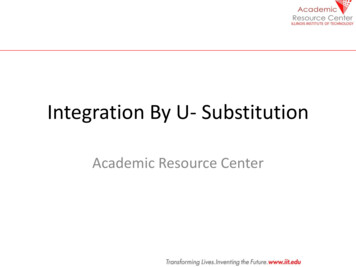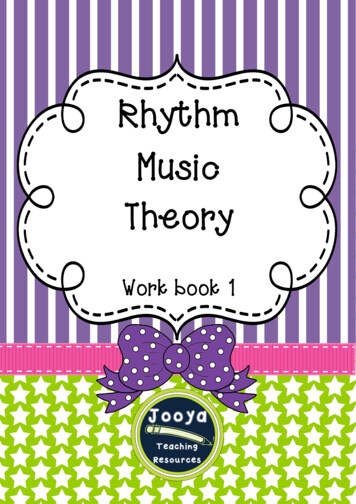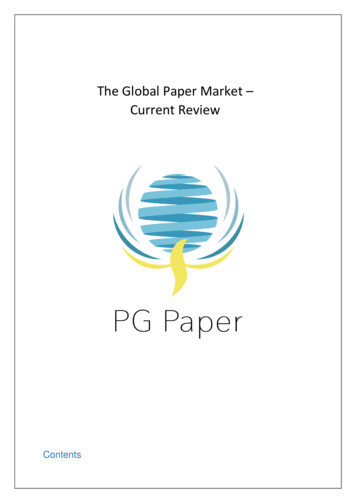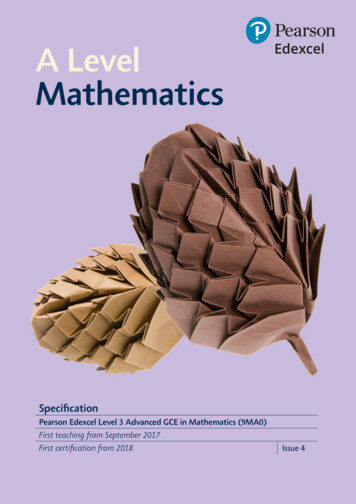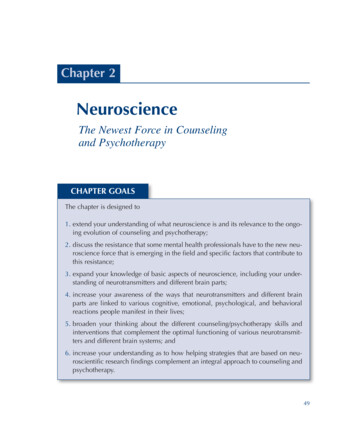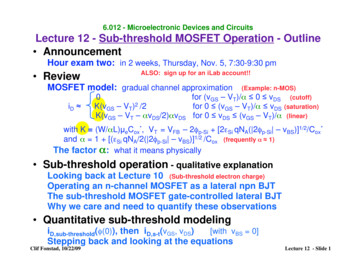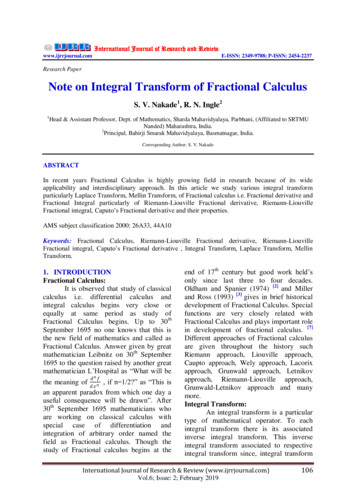
Transcription
International Journal of Research and Reviewwww.ijrrjournal.comE-ISSN: 2349-9788; P-ISSN: 2454-2237Research PaperNote on Integral Transform of Fractional CalculusS. V. Nakade1, R. N. Ingle21Head & Assistant Professor, Dept. of Mathematics, Sharda Mahavidyalaya, Parbhani, (Affiliated to SRTMUNanded) Maharashtra, India.2Principal, Bahirji Smarak Mahavidyalaya, Basmatnagar, India.Corresponding Author: S. V. NakadeABSTRACTIn recent years Fractional Calculus is highly growing field in research because of its wideapplicability and interdisciplinary approach. In this article we study various integral transformparticularly Laplace Transform, Mellin Transform, of Fractional calculus i.e. Fractional derivative andFractional Integral particularly of Riemann-Liouville Fractional derivative, Riemann-LiouvilleFractional integral, Caputo’s Fractional derivative and their properties.AMS subject classification 2000: 26A33, 44A10Keywords: Fractional Calculus, Riemann-Liouville Fractional derivative, Riemann-LiouvilleFractional integral, Caputo’s Fractional derivative , Integral Transform, Laplace Transform, MellinTransform.1. INTRODUCTIONFractional Calculus:It is observed that study of classicalcalculus i.e. differential calculus andintegral calculus begins very close orequally at same period as study ofFractional Calculus begins. Up to 30thSeptember 1695 no one knows that this isthe new field of mathematics and called asFractional Calculus. Answer given by greatmathematician Leibnitz on 30th September1695 to the question raised by another greatmathematician L’Hospital as “What will be𝑑𝑛 𝑓the meaning of 𝑑 𝑥 𝑛 , if n 1/2?” as “This isan apparent paradox from which one day auseful consequence will be drawn”. After30th September 1695 mathematicians whoare working on classical calculus withspecial case of differentiation andintegration of arbitrary order named thefield as Fractional calculus. Though thestudy of Fractional calculus begins at theend of 17th century but good work held’sonly since last three to four decades.Oldham and Spanier (1974) [2] and Millerand Ross (1993) [3] gives in brief historicaldevelopment of Fractional Calculus. Specialfunctions are very closely related withFractional Calculus and plays important rolein development of fractional calculus. [7]Different approaches of Fractional calculusare given throughout the history suchRiemann approach, Liouville approach,Caupto approach, Wely approach, Lacorixapproach, Grunwald approach, Letnikovapproach, Riemann-Liouville approach,Grunwald-Letnikov approach and manymore.Integral Transform:An integral transform is a particulartype of mathematical operator. To eachintegral transform there is its associatedinverse integral transform. This inverseintegral transform associated to respectiveintegral transform since, integral transformInternational Journal of Research & Review (www.ijrrjournal.com)Vol.6; Issue: 2; February 2019106
S. V. Nakade et.al. Note on Integral Transform of Fractional Calculusmaps its original domain into anotherdomain where it is solved very easily than inits original domain than again mapped tooriginal domain by using inverse integraltransform. There are numerous integraltransform in study. [8-10]Integral Transform of the function f (t) fort1 x t2 is defined ast2𝑇 𝑓 𝑡 𝑓 𝑡 𝐾 𝑡, 𝑥 𝑑𝑡t1Where K is the function of two variables tand x called kernel of integral transform.Choice of function K of two variablesmeans kernel is different for differentintegral transform.Inverse integral transform is of the formx2𝑓 𝑡 𝑇 𝑓 𝑥𝐾 1 𝑥, 𝑡 𝑑𝑥x1Where 𝐾 1 (𝑥, 𝑡) is the kernel of inverseintegral transform and is the inverse ofkernel K (t, x).This paper is divided in five sections whichare as followsIn section 1, we introduced about fractionalcalculus and integral transform, in section 2we see some definitions of fractionalcalculus, in section 3 some definitions ofintegral transform are given, in section 4main result means some integral transformof some fractional approaches are studiedwith their properties and section 5 is theconclusion part.2. Some Definitions of Fractionalcalculus:Riemann-Liouville Fractional Derivative:[1-6]Let α 0 and n-1 α n, n 𝜖 N, and a x b, Left hand and Right hand RiemannLiouville Fractional Derivative is defined as1𝛼𝐷𝑎 𝑓(𝑥) 𝛤(𝑛 𝛼)( 1)𝑛𝛼𝐷𝑏 𝑓(𝑥) 𝛤(𝑛 𝛼 )respectively.𝑑𝑛𝑥𝑎𝑥 𝑡𝑛 𝛼 1𝑓 𝑡 𝑑𝑡 ,𝑛𝑏𝑥𝑥 𝑡𝑛 𝛼 1𝑓 𝑡 𝑑𝑡 ,𝑑𝑥𝑑𝑑𝑥 Where, 𝛤(x) 0 𝑡 𝑥 1 . 𝑒 𝑡 𝑑𝑡 , called asEuler’s Gamma function.If α 𝜖 N then these definitions acts as likeclassical derivative of order α.In general Riemann-Liouville FractionalDerivative of order α of the function f(x)with a x b is defined asDα f(x) n1dΓ(n α)dxxan α 1x tf t dt ,If 0 α 1, we obtain1d x f(t)Dα f(x) Γ(1 α) dx a (x t)α dt .Riemann-Liouville Fractional Integral:Let α 0 and n-1 α n , n 𝜖 N, and a x b , Left hand and Right hand RiemannLiouville Fractional integral is defined asx1αIa f(x) Γ(α) a x t α 1 f t dt ,1αIb f(x) Γ(α)bxx tα 1f t dt ,In general Riemann-Liouville Fractionalintegral of order α 𝜖 (- , ) of the functionf(x) with a x b is defined as𝐼𝛼 𝑓(𝑥) 𝐷 𝛼 f(x) 1Γ(α)xax tα 1f t dt .Caputo Fractional Derivative:Let α 0 and n-1 α n, n 𝜖 N, and a x b, Left hand and Right hand CaputoFractional derivative is defined asC 𝛼𝐷𝑎 𝑓(𝑥)𝑥𝑎1 𝛤(𝑛 𝛼)C 𝛼𝐷𝑏 𝑓(𝑥) ( 1)𝑛𝛤(𝑛 𝛼 )𝑏𝑥𝑥 𝑡𝑥 𝑡𝑛 𝛼 1𝑛 𝛼 1𝑓𝑓𝑛𝑛(𝑡) 𝑑𝑡 ,(𝑡) 𝑑𝑡 ,In general, Caputo Fractional derivative oforder α 𝜖 (- , ) of the function f(x) with a x b is defined as𝑐 𝛼𝑎 𝐷𝑥 𝑓(𝑥)1 𝛤(𝑛 𝛼)𝑥𝑎𝑥 𝑡𝑛 𝛼 1𝑓𝑛(𝑡) 𝑑𝑡 ,Where n-1 α n.3. Some Integral Transform:Laplace Transform:Laplace Transform [8] is very useful insolving differential equations especiallywhen initial values are zero. The LaplaceTransform of a function f(x) defined for allreal number x 0 is the function F(s) givenbyInternational Journal of Research & Review (www.ijrrjournal.com)Vol.6; Issue: 2; February 2019107
S. V. Nakade et.al. Note on Integral Transform of Fractional Calculus(f (t)) 𝐹(𝑠) 0𝑓(𝑡)𝑒 𝑠𝑡 dt,Inverse Laplace transform of F(s) i.e. f (t) isgiven by𝑐 𝑖 ℒ 1 𝐹 𝑠 𝑓 𝑡 𝑐 𝑖 𝑒 𝑠 F(s)ds,c Re(s) c0,where c0 lies in right half plane of theabsolute convergence of Laplace integral.Some properties of Laplace Transform:i){a f(t)} a{f(t)} ; where a isconstant.ii) {a f(t) b g(t)} a {f(t)} b{g(t)} ; Linearityiii) If{f(t)} 𝐹(𝑠) then {f(at)} 1𝑠 𝐹(𝑎 ) ; change of scaleiv) Convolution property: If F(s) and G(s)are the Laplace Transform of f(x) andg(x) respectively, thenℒ{ F(x) * g(x); s} F(s) G(s)𝑥 ℒ 0 𝑓 𝑥 𝑧 𝑔 𝑧 𝑑𝑧 ,Where convolution is given by𝑥f * g 0 𝑓 𝑥 𝑧 𝑔 𝑧 𝑑𝑧 .v) The Laplace transform of the n-th (n 𝜖N) derivative of f(x) is given by𝑎Whereis the the Mellin transformoperator and s is the Mellin transformvariablewhich is complex number.Inverse mellin transform is defined asℳ 1 𝐹 𝑠nx : s 𝑠𝑛 𝐹 𝑠 𝑠 𝑛 𝑘 1 𝑓𝑘𝑛 1 𝑘 𝑛 𝑘 1𝑘 0 𝑠 𝑓𝑐 𝑖 𝑐 𝑖 𝑥 𝑠 𝐹 𝑠 𝑑𝑠Some properties of Mellin Transform:i){a f(t)} a ℳ{f(t)} ; where a isconstantii){a f(t) b g(t)} a{f(t)} b{g(t)} ; Linearityiii) If{f(t)} 𝐹(𝑠) then{f(at)} 𝑎 𝑠𝐹 𝑠 ; change of scaleiv) Convolution property : If F(s) and G(s)are the Mellin Transform of f(x) andg(x) respectively, thena.f(x) * g(x); s} F(s) G(s) 𝑐 𝑖 12𝜋𝑖 𝑐 𝑖 𝑓 𝑠 𝑧 𝑔 𝑧 𝑑𝑧b. Where convolution is given by𝑥c. f * g 0 𝑓 𝑥 𝑧 𝑔 𝑧 𝑑𝑧 .v) The Mellin transform of the n-th (n 𝜖 N)derivative of f(x) is given byℳ fnx : s ( 1)𝑘𝛤(𝑠)𝐹 𝑠 𝑘𝛤(𝑠 𝑘)0𝑘 0 𝑠𝑛 𝐹 𝑠 12𝜋𝑖Where ℳ 1 is the inverse Mellin transformoperator.𝑛 1ℒ f 𝑓 𝑥 0Mellin Transform:Mellin Transform [10] is closely relatedwith Laplace transform and Fouriertransform. Hjalmar Mellin (1854–1933)gave his name to the Mellin transform 0f afunction f(x) defined over the positive real’s,the complex function M [f (x); s]. MellinTransform is the multiplicative version oftwo sided Laplace Transform.4. Integral transform of some fractionalapproaches:5.Laplace Transform of the RiemannLiouville Fractional Integral:The Riemann-Liouville Fractional Integralis given by1D α f(x) Γ(α)x tα 1f t dt .aIts Laplace transform is given byℒ 𝐷 𝛼 f(x) The mellin Transform of a function f isdefined as ℳ{f(x)} F(s) 0 𝑥 𝑠 1 𝑓 𝑥 𝑑𝑥x1Γ(α)ℒ x 1 ℒ f x s F(s),α 0.Following table gives Laplace transform ofsome function and their fractional integrals:International Journal of Research & Review (www.ijrrjournal.com)Vol.6; Issue: 2; February 2019108
S. V. Nakade et.al. Note on Integral Transform of Fractional Calculusf(x)𝑒 𝑎𝑥𝑥𝑣𝑥 𝑣 1 𝑒 𝑎𝑥Cos(ax)Sin(ax)𝐷 𝛼 {f x }𝐷 𝛼 {𝑒 𝑎𝑥 }F(s) {f(x)}1𝑠 𝑎𝛤(𝑣 1)𝑠 𝑣 1𝛤(𝑣)(𝑠 𝑎)𝑣𝑠𝑠 2 𝑎2𝑎𝑠 2 𝑎2 𝐷 𝛼 f(x)1𝑠 𝛼 (𝑠 𝑎)𝛤(𝑣 1)𝑠 𝛼 𝑣 1𝛤(𝑣)𝑠 𝛼 (𝑠 𝑎)𝑣𝑠𝑠 𝛼 (𝑠 2 𝑎2 )𝑎𝑠 𝛼 (𝑠 2 𝑎2 )𝐷 𝛼 {𝑥 𝑣 }𝐷 𝛼 {𝑥 𝑣 1 𝑒 𝑎𝑥 }𝐷 𝛼{cos (ax)}𝐷 𝛼 {sin ax }Laplace Transform of the RiemannLiouville Fractional al operator is given byxn1dD f(x) Γ(n α) dxαn α 1x tf t dt ,aThe Laplace transform of RiemannLiouville Fractional differential operator isgiven byℒ Dα f(x): s 𝑠 𝛼 𝐹 𝑠 𝑛 1 𝑘𝛼 𝑘 1𝑓 0𝑘 0 𝑠 𝐷𝑛 1 𝑛 𝑘 1𝛼 𝑠 𝐹 𝑠 𝑘 0 𝑠𝐷𝑘 𝐼 𝑛 𝛼 𝑓 0Laplace Transform of the CaputoFractional DerivativeThe Caputo Fractional Differential operatoris given by𝑐 𝛼𝑎 𝐷𝑥 𝑓(𝑥)1 𝛤(𝑛 𝛼)𝑥𝑎𝑥 𝑡𝑛 𝛼 1𝑓𝑛(𝑡) 𝑑𝑡 ,The Laplace transform of Caputo FractionalDifferential operator is given byℒ 𝑎𝑐 𝐷𝑥𝛼 𝑓(𝑥): s 𝑠 𝛼 𝐹 𝑠𝑛 1𝑠 𝛼 𝑘 1 𝑓 𝑘0 , 𝑛𝑘 0 1 𝛼 𝑛.Mellin Transform of the RiemannLiouville Fractional Integral:Mellin transform of Riemann-Liouvillefractional integral operator is given byℳ{𝐷 𝛼 f(x)} F(s) Γ(1 s α)Γ(1 s)F(s α)Mellin Transform of the in transform of Riemann-Liouville andCaputo fractional derivative operator isgiven byΓ(1 s α )ℳ{𝐷𝛼 f(x)} F(s) F(s - α)Γ(1 s)6. CONCLUSIONApplications of Fractional calculus arefound in almost all sciences. FractionalCalculus is the topic of today’s researchers.Fractional calculus is termed as a solution toreal world problems. Integral transform areuseful in finding solution of differentialequations. Solving fractional differentialequation is very tedious task. Extendingintegral transform to solve fractionaldifferential equations is the target toachieve.In this paper we study differentapproaches of fractional calculus and theirproperties.Also we study integral transformwith their properties and the integraltransform particularly Laplace transformand Mellin transform of Riemann-Liouvilleintegral operator, Riemann-Liouville andCaputo differential operator.REFERENCES1. Podlubny,FractionalDifferentialEquations, Academic Press, New York,(1999).2. K. B. Oldham, J. Spanier, TheFractional Calculus, Academic Press,New York, (1974).3. K.S. Miller and B. Ross, AnIntroduction to the Fractional Calculusand Fractional differential EquationsWiley, 1993.4. S. Samko, A. Kilbas, O. Marichev;Fractional integrals and derivative:Theory and Applications, Gordon andBreach science publisher, 1993.5. Gorenflo R. and Mainardi F., Essentialsof fractional calculus, MaPhySto Center,2000.6. Greenberg M., Foundations of appliedmathematics,Prentice-HallInc.,Englewood Cliffs, N.J. 07632, 1978.International Journal of Research & Review (www.ijrrjournal.com)Vol.6; Issue: 2; February 2019109
S. V. Nakade et.al. Note on Integral Transform of Fractional Calculus7. S. V. Nakade, R.N. Ingle, Study of someSpecial functions in Fractional Calculus,International Innovative Journal, ISSN2319-8648.SpecialIssueforInternational conference on AppliedScience 2017.8. M. Abramowitz and I. Stegun,Handbook of mathematical functions,Dover, New York, 1964.9. Sneddon Ian N. The use of IntegralTransform, McGraw-Hill Book Co.,NY1972.10. Erdelyi,A.,W.Magnus,F.Oberhettinger and F.G.Tricomi, Tablesof Integral Transfer, McGraw-Hill BookCo., NY1954.How to cite this article: Nakade SV, Ingle RN. Note on integral transform of fractional calculus.International Journal of Research and Review. 2019; 6(2):106-110.******International Journal of Research & Review (www.ijrrjournal.com)Vol.6; Issue: 2; February 2019110
Mellin Transform: Mellin Transform [10] is closely related with Laplace transform and Fourier transform. Hjalmar Mellin (1854–1933) gave his name to the Mellin transform 0f a function f(x) defined over the positive real’s, the complex function M [f (x); s]. M

